
An underwater explosion (also known as an UNDEX) is a chemical or nuclear explosion that occurs under the surface of a body of water. While useful in anti-ship and submarine warfare, underwater bombs are not as effective against coastal facilities.

An underwater explosion (also known as an UNDEX) is a chemical or nuclear explosion that occurs under the surface of a body of water. While useful in anti-ship and submarine warfare, underwater bombs are not as effective against coastal facilities.
Underwater explosions differ from in-air explosions due to the properties of water:
Effects of an underwater explosion depend on several things, including distance from the explosion, the energy of the explosion, the depth of the explosion, and the depth of the water. [2]
Underwater explosions are categorized by the depth of the explosion. Shallow underwater explosions are those where a crater formed at the water's surface is large in comparison with the depth of the explosion. Deep underwater explosions are those where the crater is small in comparison with the depth of the explosion, [2] or nonexistent.
The overall effect of an underwater explosion depends on depth, the size and nature of the explosive charge, and the presence, composition and distance of reflecting surfaces such as the seabed, surface, thermoclines, etc. This phenomenon has been extensively used in antiship warhead design since an underwater explosion (particularly one underneath a hull) can produce greater damage than an above-surface one of the same explosive size. Initial damage to a target will be caused by the first shockwave; this damage will be amplified by the subsequent physical movement of water and by the repeated secondary shockwaves or bubble pulse. Additionally, charge detonation away from the target can result in damage over a larger hull area. [3]
Underwater nuclear tests close to the surface can disperse radioactive water and steam over a large area, with severe effects on marine life, nearby infrastructures and humans. [4] [5] The detonation of nuclear weapons underwater was banned by the 1963 Partial Nuclear Test Ban Treaty and it is also prohibited under the Comprehensive Nuclear-Test-Ban Treaty of 1996.
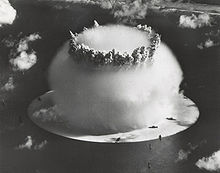
The Baker nuclear test at Bikini Atoll in July 1946 was a shallow underwater explosion, part of Operation Crossroads. A 20 kiloton warhead was detonated in a lagoon which was approximately 200 ft (61 m) deep. The first effect was illumination of the sea from the underwater fireball. A rapidly expanding gas bubble created a shock wave that caused an expanding ring of apparently dark water at the surface, called the slick, followed by an expanding ring of apparently white water, called the crack. A mound of water and spray, called the spray dome, formed at the water's surface which became more columnar as it rose. When the rising gas bubble broke the surface, it created a shock wave in the air as well. Water vapor in the air condensed as a result of Prandtl–Meyer expansion fans decreasing the air pressure, density, and temperature below the dew point; making a spherical cloud that marked the location of the shock wave. Water filling the cavity formed by the bubble caused a hollow column of water, called the chimney or plume, to rise 6,000 ft (1,800 m) in the air and break through the top of the cloud. A series of ocean surface waves moved outward from the center. The first wave was about 94 ft (29 m) high at 1,000 ft (300 m) from the center. Other waves followed, and at further distances some of these were higher than the first wave. For example, at 22,000 ft (6,700 m) from the center, the ninth wave was the highest at 6 ft (1.8 m). Gravity caused the column to fall to the surface and caused a cloud of mist to move outward rapidly from the base of the column, called the base surge. The ultimate size of the base surge was 3.5 mi (5.6 km) in diameter and 1,800 ft (550 m) high. The base surge rose from the surface and merged with other products of the explosion, to form clouds which produced moderate to heavy rainfall for nearly one hour. [6]
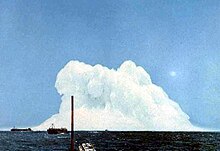
An example of a deep underwater explosion is the Wahoo test, which was carried out in 1958 as part of Operation Hardtack I. A 9 kt Mk-7 was detonated at a depth of 500 ft (150 m) in deep water. There was little evidence of a fireball. The spray dome rose to a height of 900 ft (270 m). Gas from the bubble broke through the spray dome to form jets which shot out in all directions and reached heights of up to 1,700 ft (520 m). The base surge at its maximum size was 2.5 mi (4.0 km) in diameter and 1,000 ft (300 m) high. [6]
The heights of surface waves generated by deep underwater explosions are greater because more energy is delivered to the water. During the Cold War, underwater explosions were thought to operate under the same principles as tsunamis, potentially increasing dramatically in height as they move over shallow water, and flooding the land beyond the shoreline. [7] Later research and analysis suggested that water waves generated by explosions were different from those generated by tsunamis and landslides. Méhauté et al. conclude in their 1996 overview Water Waves Generated by Underwater Explosion that the surface waves from even a very large offshore undersea explosion would expend most of their energy on the continental shelf, resulting in coastal flooding no worse than that from a bad storm. [2]
The Operation Wigwam test in 1955 occurred at a depth of 2,000 ft (610 m), the deepest detonation of any nuclear device.


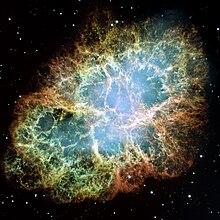

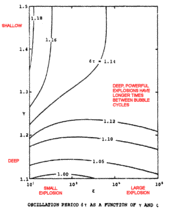

Unless it breaks the water surface while still a hot gas bubble, an underwater nuclear explosion leaves no trace at the surface but hot, radioactive water rising from below. This is always the case with explosions deeper than about 2,000 ft (610 m). [6]
About one second after such an explosion, the hot gas bubble collapses because:
Since water is not readily compressible, moving this much of it out of the way so quickly absorbs a massive amount of energy—all of which comes from the pressure inside the expanding bubble. Water pressure outside the bubble soon causes it to collapse back into a small sphere and rebound, expanding again. This is repeated several times, but each rebound contains only about 40% of the energy of the previous cycle.
At the maximum diameter of the first oscillation, a very large nuclear bomb exploded in very deep water creates a bubble about a half-mile (800 m) wide in about one second and then contracts, which also takes about a second. Blast bubbles from deep nuclear explosions have slightly longer oscillations than shallow ones. They stop oscillating and become mere hot water in about six seconds. This happens sooner in nuclear blasts than bubbles from conventional explosives.
The water pressure of a deep explosion prevents any bubbles from surviving to float up to the surface.
The drastic 60% loss of energy between oscillation cycles is caused in part by the extreme force of a nuclear explosion pushing the bubble wall outward supersonically (faster than the speed of sound in saltwater). This causes Rayleigh–Taylor instability. That is, the smooth water wall touching the blast face becomes turbulent and fractal, with fingers and branches of cold ocean water extending into the bubble. That cold water cools the hot gas inside and causes it to condense. The bubble becomes less of a sphere and looks more like the Crab Nebula—the deviation of which from a smooth surface is also due to Rayleigh–Taylor instability as ejected stellar material pushes through the interstellar medium.
As might be expected, large, shallow explosions expand faster than deep, small ones.
Despite being in direct contact with a nuclear explosion fireball, the water in the expanding bubble wall does not boil; the pressure inside the bubble exceeds (by far) the vapor pressure of water. The water touching the blast can only boil during bubble contraction. This boiling is like evaporation, cooling the bubble wall, and is another reason that an oscillating blast bubble loses most of the energy it had in the previous cycle.
During these hot gas oscillations, the bubble continually rises for the same reason a mushroom cloud does: it is less dense. This causes the blast bubble never to be perfectly spherical. Instead, the bottom of the bubble is flatter, and during contraction, it even tends to "reach up" toward the blast center.
In the last expansion cycle, the bottom of the bubble touches the top before the sides have fully collapsed, and the bubble becomes a torus in its last second of life. About six seconds after detonation, all that remains of a large, deep nuclear explosion is a column of hot water rising and cooling in the near-freezing ocean.
Relatively few underwater nuclear tests were performed before they were banned by the Partial Test Ban Treaty. They are:
| Test series | Name | Nation | Date (UT) | Location | Bomb depth, depth of water | Yield | Notes |
|---|---|---|---|---|---|---|---|
| Crossroads | Baker | US | July 25, 1946 | Bikini Atoll, PPG | 50 m (160 ft), 100 m (330 ft) | 20 kt | Probe the effects of a shallow underwater nuclear bomb on various surface fleet units. |
| Hurricane | Hurricane | UK | October 2, 1952 | Monte Bello Islands | 2.7 m (8 ft 10 in), 12 m (39 ft) | 25 kt | First British nuclear test. Nuclear effects test of a ship-smuggled nuclear bomb at a port. |
| Wigwam | Wigwam | US | May 14, 1955 | North Pacific Ocean | 610 m (2,000 ft), 4,880 m (16,010 ft) | 30 kt | A Mark 90-B7 "Betty" nuclear depth charge test to determine specifically submarine vulnerability to deep atomic depth charges. |
| 1955 | 22 (Joe 17) | USSR | September 21, 1955 | Chernaya Bay, Novaya Zemlya | 10 m (33 ft), unknown | 3.5 kt | Test of a nuclear torpedo. |
| 1957 | 48 | USSR | October 10, 1957 | Novaya Zemlya | 30 m (98 ft), unknown | 6 kt | A T-5 torpedo test. |
| Hardtack I | Wahoo | US | May 16, 1958 | Outside Enewetak Atoll, PPG | 150 m (490 ft), 980 m (3,220 ft) | 9 kt | Test of a deep water bomb against ship hulls. |
| Hardtack I | Umbrella | US | June 8, 1958 | Inside Enewetak Atoll, PPG | 46 m (151 ft), 46 m (151 ft) | 9 kt | Test of a shallow water bomb on ocean floor against ship hulls. |
| 1961 | 122 (Korall-1) | USSR | October 23, 1961 | Novaya Zemlya | 20 m (66 ft), unknown | 4.8 kt | A T-5 torpedo test. |
| Dominic | Swordfish | US | May 11, 1962 | Pacific Ocean, near Johnston Island | 198 m (650 ft), 1,000 m (3,300 ft) | <20 kt | Test of the RUR-5 ASROC system. |
Note: it is often believed that the French did extensive underwater tests in French West Polynesia on the Moruroa and Fangataufa Atolls. This is incorrect; the bombs were placed in shafts drilled into the underlying coral and volcanic rock, and they did not intentionally leak fallout.
There are several methods of detecting nuclear detonations. Hydroacoustics is the primary means of determining if a nuclear detonation has occurred underwater. Hydrophones are used to monitor the change in water pressure as sound waves propagate through the world's oceans. [9] Sound travels through 20 °C water at approximately 1482 meters per second, compared to the 332 m/s speed of sound through air. [10] [11] In the world's oceans, sound travels most efficiently at a depth of approximately 1000 meters. Sound waves that travel at this depth travel at minimum speed and are trapped in a layer known as the Sound Fixing and Ranging Channel (SOFAR). [9] Sounds can be detected in the SOFAR from large distances, allowing for a limited number of monitoring stations required to detect oceanic activity. Hydroacoustics was originally developed in the early 20th century as a means of detecting objects like icebergs and shoals to prevent accidents at sea. [9]
Three hydroacoustic stations were built before the adoption of the Comprehensive Nuclear-Test-Ban Treaty. Two hydrophone stations were built in the North Pacific Ocean and Mid-Atlantic Ocean, and a T-phase [ clarification needed ] station was built off the west coast of Canada. When the CTBT was adopted, 8 more hydroacoustic stations were constructed to create a comprehensive network capable of identifying underwater nuclear detonations anywhere in the world. [12] These 11 hydroacoustic stations, in addition to 326 monitoring stations and laboratories, comprise the International Monitoring System (IMS), which is monitored by the Preparatory Commission for the Comprehensive Nuclear-Test-Ban Treaty Organization (CTBTO). [13]
There are two different types of hydroacoustic stations currently used in the IMS network; 6 hydrophone monitoring stations and 5 T-phase stations. These 11 stations are primarily located in the southern hemisphere, which is primarily ocean. [14] Hydrophone monitoring stations consist of an array of three hydrophones suspended from cables tethered to the ocean floor. They are positioned at a depth located within the SOFAR in order to effectively gather readings. [12] Each hydrophone records 250 samples per second, while the tethering cable supplies power and carries information to the shore. [12] This information is converted to a usable form and transmitted via secure satellite link to other facilities for analysis. T-phase monitoring stations record seismic signals generate from sound waves that have coupled with the ocean floor or shoreline. [15] T-phase stations are generally located on steep-sloped islands in order to gather the cleanest possible seismic readings. [14] Like hydrophone stations, this information is sent to the shore and transmitted via satellite link for further analysis. [15] Hydrophone stations have the benefit of gathering readings directly from the SOFAR, but are generally more expensive to implement than T-phase stations. [15] Hydroacoustic stations monitor frequencies from 1 to 100 Hertz to determine if an underwater detonation has occurred. If a potential detonation has been identified by one or more stations, the gathered signals will contain a high bandwidth with the frequency spectrum indicating an underwater cavity at the source. [15]
{{cite web}}: CS1 maint: multiple names: authors list (link){{cite web}}: CS1 maint: multiple names: authors list (link)
The Comprehensive Nuclear-Test-Ban Treaty (CTBT) is a multilateral treaty to ban nuclear weapons test explosions and any other nuclear explosions, for both civilian and military purposes, in all environments. It was adopted by the United Nations General Assembly on 10 September 1996, but has not entered into force, as eight specific nations have not ratified the treaty.

A bomb is an explosive weapon that uses the exothermic reaction of an explosive material to provide an extremely sudden and violent release of energy. Detonations inflict damage principally through ground- and atmosphere-transmitted mechanical stress, the impact and penetration of pressure-driven projectiles, pressure damage, and explosion-generated effects. Bombs have been utilized since the 11th century starting in East Asia.

The Tsar Bomba, also known by the alphanumerical designation "AN602", was a thermonuclear aerial bomb, and the most powerful nuclear weapon ever created and tested. The Soviet physicist Andrei Sakharov oversaw the project at Arzamas-16, while the main work of design was by Sakharov, Viktor Adamsky, Yuri Babayev, Yuri Smirnov, and Yuri Trutnev. The project was ordered by Nikita Khrushchev in July 1961 as part of the Soviet resumption of nuclear testing after the Test Ban Moratorium, with the detonation timed to coincide with the 22nd Congress of the Communist Party of the Soviet Union.

A depth charge is an anti-submarine warfare (ASW) weapon designed to destroy submarines by detonating in the water near the target and subjecting it to a destructive hydraulic shock. Most depth charges use high explosives with a fuze set to detonate the charge, typically at a specific depth from the surface. Depth charges can be dropped by ships, patrol aircraft and helicopters.

Operation Crossroads was a pair of nuclear weapon tests conducted by the United States at Bikini Atoll in mid-1946. They were the first nuclear weapon tests since Trinity on July 16, 1945, and the first detonations of nuclear devices since the atomic bombing of Nagasaki on August 9, 1945. The purpose of the tests was to investigate the effect of nuclear weapons on warships.
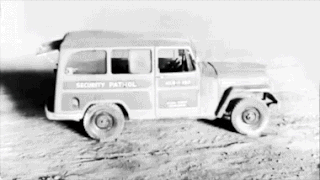
The effects of a nuclear explosion on its immediate vicinity are typically much more destructive and multifaceted than those caused by conventional explosives. In most cases, the energy released from a nuclear weapon detonated within the lower atmosphere can be approximately divided into four basic categories:

A mushroom cloud is a distinctive mushroom-shaped flammagenitus cloud of debris, smoke, and usually condensed water vapor resulting from a large explosion. The effect is most commonly associated with a nuclear explosion, but any sufficiently energetic detonation or deflagration will produce the same effect. They can be caused by powerful conventional weapons, like thermobaric weapons such as the ATBIP and GBU-43/B MOAB. Some volcanic eruptions and impact events can produce natural mushroom clouds.

Ivy Mike was the codename given to the first full-scale test of a thermonuclear device, in which part of the explosive yield comes from nuclear fusion. Ivy Mike was detonated on November 1, 1952, by the United States on the island of Elugelab in Enewetak Atoll, in the now independent island nation of the Marshall Islands, as part of Operation Ivy. It was the first full test of the Teller–Ulam design, a staged fusion device.

Operation Wigwam involved a single test of the Mark 90 "Betty" nuclear bomb. It was conducted between Operation Teapot and Project 56 on May 14, 1955, about 500 miles (800 km) southwest of San Diego, California. 6,800 personnel aboard 30 ships were involved in Wigwam. The purpose of Wigwam was to determine the vulnerability of submarines to deeply detonated nuclear weapons, and to evaluate the feasibility of using such weapons in a combat situation. The task force commander, Admiral John Sylvester, was embarked on the task force flagship USS Mount McKinley. Wigwam was the first atomic test in the deep ocean, and it remains the only test that has been conducted in water deeper than 1,000 ft (300 m).

Operation Hardtack I was a series of 35 nuclear tests conducted by the United States from April 28 to August 18 in 1958 at the Pacific Proving Grounds. At the time of testing, the Operation Hardtack I test series included more nuclear detonations than the total of prior nuclear explosions in the Pacific Ocean. These tests followed the Project 58/58A series, which occurred from 1957 December 6 to 1958, March 14, and preceded the Operation Argus series, which took place in 1958 from August 27 to September 6.

The SOFAR channel, or deep sound channel (DSC), is a horizontal layer of water in the ocean at which depth the speed of sound is at its minimum. The SOFAR channel acts as a waveguide for sound, and low frequency sound waves within the channel may travel thousands of miles before dissipating. An example was reception of coded signals generated by the Navy chartered ocean surveillance vessel Cory Chouest off Heard Island, located in the southern Indian Ocean, by hydrophones in portions of all five major ocean basins and as distant as the North Atlantic and North Pacific.

Submarine volcanoes are underwater vents or fissures in the Earth's surface from which magma can erupt. Many submarine volcanoes are located near areas of tectonic plate formation, known as mid-ocean ridges. The volcanoes at mid-ocean ridges alone are estimated to account for 75% of the magma output on Earth. Although most submarine volcanoes are located in the depths of seas and oceans, some also exist in shallow water, and these can discharge material into the atmosphere during an eruption. The total number of submarine volcanoes is estimated to be over one million of which some 75,000 rise more than 1 kilometre (0.62 mi) above the seabed. Only 119 submarine volcanoes in Earth's oceans and seas are known to have erupted during the last 11,700 years.
The Comprehensive Nuclear-Test-Ban Treaty Organization (CTBTO) is an international organization that will be established upon the entry into force of the Comprehensive Nuclear-Test-Ban Treaty, a Convention that outlaws nuclear test explosions. Its seat will be in Vienna, Austria. The organization will be tasked with verifying the ban on nuclear tests and will operate therefore a worldwide monitoring system and may conduct on-site inspections. The Preparatory Commission for the CTBTO, and its Provisional Technical Secretariat, were established in 1997 and are headquartered in Vienna, Austria.

Operation Tumbler–Snapper was a series of nuclear weapons tests conducted by the United States in early 1952 at the Nevada Test Site. The Tumbler–Snapper series of tests followed Operation Buster–Jangle and preceded Operation Ivy.

Underground nuclear testing is the test detonation of nuclear weapons that is performed underground. When the device being tested is buried at sufficient depth, the nuclear explosion may be contained, with no release of radioactive materials to the atmosphere.

Project Gnome was the first nuclear test of Project Plowshare and was the first continental nuclear weapon test since Trinity to be conducted outside of the Nevada Test Site, and the second test in the state of New Mexico after Trinity. It was tested in southeastern New Mexico on December 10, 1961, approximately 40 km southeast of Carlsbad, New Mexico.

Underwater acoustics is the study of the propagation of sound in water and the interaction of the mechanical waves that constitute sound with the water, its contents and its boundaries. The water may be in the ocean, a lake, a river or a tank. Typical frequencies associated with underwater acoustics are between 10 Hz and 1 MHz. The propagation of sound in the ocean at frequencies lower than 10 Hz is usually not possible without penetrating deep into the seabed, whereas frequencies above 1 MHz are rarely used because they are absorbed very quickly.

The Preparatory Commission for the Comprehensive Nuclear-Test-Ban Treaty Organization, or CTBTO Preparatory Commission, is an international organization based in Vienna, Austria, that is tasked with building up the verification regime of the Comprehensive Nuclear-Test-Ban Treaty Organization (CTBTO). The organization was established by the States Signatories to the Comprehensive Nuclear-Test-Ban Treaty (CTBT) in 1996.
A nuclear detonation detection system (NDDS) is a device or a series of devices that are able to indicate, and pinpoint a nuclear explosion has occurred as well as the direction of the explosion. The main purpose of these devices or systems was to verify compliance of countries that signed nuclear treaties such as the Partial Test Ban treaty of 1963 (PTBT) and the Treaty of Tlatelolco.
The Missile Impact Location System or Missile Impact Locating System (MILS) is an ocean acoustic system designed to locate the impact position of test missile nose cones at the ocean's surface and then the position of the cone itself for recovery from the ocean bottom. The systems were installed in the missile test ranges managed by the U.S. Air Force.